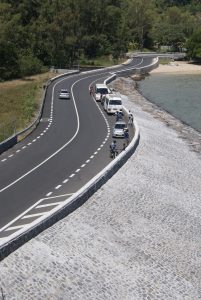Share this article
Be the first to know about our new projects.
2Futures has many new luxury projects in the pipeline. Get notified before the public when there’s a new launch. Benefit from early bird specials.
An efficient public transport system and a well-developed road network await foreigners. The whole island, with an area of 2,040 square kilometres, has about 2,100 kilometres of paved roads. Hence, moving about by land is quite easy in Mauritius.
Three main motorways cover Mauritius, and these are the M1, M2, and M3 that are classified as freeways forking out to smaller secondary roads. The island is just 45 kilometres wide and 65 kilometres long. So with this road network, a trip across Mauritius from north to south can take just around three hours.
The M1is the motorway that folks who are first-time visitors would get to travel. After all, it runs from the country’s international airport to Port Louis, the capital.
The M1 stretch is the longest at 47 kilometres. Besides linking the airport to the capital, this motorway also traverses several Mauritius districts, towns and villages. These include Moka, Beau Bassin-Rose Hill, Quatre Bornes, Vacoas-Phoenix, and Curepipe.

The M2 is the motorway serving motorists from Port Louis towards north to Grand Baie. Its 23-kilometre stretch also connects the district of Pamplemousses to the capital. The M3, on the other hand, is a link road from the district of Moka northwards bypassing Port Louis.
An extensive bus network of around 220 bus lines mainly provides the public transportation in Mauritius. The state-owned National Transport Corporation, four private companies, and individual operators, run the public buses in Mauritius.
In January 2020, a Passenger Information System (PIS) was launched on a pilot basis to provide commuters real-time information on bus route schedules. The PIS is part of a government initiative to modernize the transport system across Mauritius. It initially covers the Curepipe-Floreal corridor to Port Louis. The PIS launch also introduced the mobile app “maubis” to provide commuters access through their smartphones real-time information on bus departure and arrival along a particular route.
A light rail transit system called Metro Express is likewise now serving Mauritius. The system’s first phase became operational in January 2020, and the completion of the second phase is expected in September 2021.
Costing some MUR18.8 billion, Metro Express covers a 26-kilometres route from Curepipe to Immigration Square in Port Louis. It is set of 19 stations to serve commuters in Curepipe, Vacoas, Rose Hill, Quatre Bornes, and Port Louis.
The government also plans a north–south expansion of the Metro Express for a direct link to the airport. Significantly, the light rail system schedule is likewise in sync with the new Passenger Information Service for buses. This linkage facilitates quicker transfers from trains to public buses, definitely an add-on to the benefits.
Transport infrastructure boosts Mauritius property investment